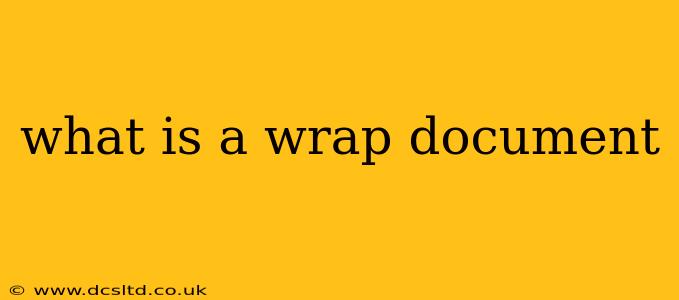A wrap document, also sometimes called a wrap-up report or project wrap-up report, is a concise summary of a completed project or initiative. It provides a high-level overview of the project's goals, accomplishments, challenges encountered, and overall outcomes. Think of it as the final bow on a project, tying together all loose ends and offering a valuable record for future reference. Unlike detailed project reports, which delve into minute specifics, wrap documents prioritize a clear and easily digestible summary of key information.
Why Are Wrap Documents Important?
Wrap documents serve several crucial purposes:
- Knowledge Transfer: They preserve critical project information, ensuring that lessons learned and valuable insights are not lost when team members move on to other projects. This is especially vital for larger projects with multiple stakeholders.
- Accountability and Transparency: They provide a transparent record of the project's progress, achievements, and any deviations from the initial plan. This aids in evaluating project success and identifying areas for improvement in future endeavors.
- Future Planning: By analyzing the successes and failures documented in the wrap document, organizations can gain valuable insights to inform the planning and execution of future projects. Patterns and trends become evident, leading to better decision-making.
- Stakeholder Communication: They offer a clear and concise update to stakeholders, providing them with a final overview of the project's performance and its impact.
What Information Should a Wrap Document Include?
While the specific content of a wrap document can vary based on the project's nature and complexity, several key elements are generally included:
- Project Overview: A brief summary of the project's goals, objectives, and scope.
- Key Accomplishments: A clear and concise list of the project's major achievements and milestones met. Quantifiable results are highly valuable here.
- Challenges and Lessons Learned: An honest assessment of the difficulties encountered during the project, along with the lessons learned from overcoming these challenges. This is crucial for continuous improvement.
- Overall Assessment: A summary evaluation of the project's overall success, considering both quantitative and qualitative factors. Did it meet its objectives? Were there unexpected outcomes?
- Recommendations for Future Projects: Based on the lessons learned, what recommendations can be made to improve future projects of a similar nature?
- Key Metrics and Data: Include relevant quantitative data to support claims of success or areas for improvement. Use charts and graphs where appropriate for visual impact.
What is the Difference Between a Wrap Document and a Final Project Report?
The key difference lies in the level of detail and the intended audience. A final project report is typically much more extensive and detailed, delving into the technical aspects of the project, including methodologies, data analysis, and specific tasks completed. It's often geared towards a technical audience. A wrap document, on the other hand, is a shorter, high-level summary designed for a broader audience, including stakeholders, management, and other interested parties. It focuses on the key outcomes and lessons learned, rather than the granular details of the project execution.
How Long Should a Wrap Document Be?
The ideal length of a wrap document depends on the complexity of the project. However, aiming for conciseness is always recommended. A well-written wrap document can effectively summarize even a large project within a few pages. Prioritize clarity and impactful information over excessive detail.
Who is Responsible for Writing a Wrap Document?
The responsibility for creating a wrap document usually falls upon the project manager or a designated team member. However, input from various team members is crucial to ensure a comprehensive and accurate representation of the project's outcomes. Collaboration ensures that the document reflects the collective experience and knowledge gained during the project.
In conclusion, a well-crafted wrap document is an invaluable asset for any organization. It serves as a powerful tool for knowledge preservation, continuous improvement, and effective communication, ensuring that the hard work and insights gained from a project are not forgotten.
